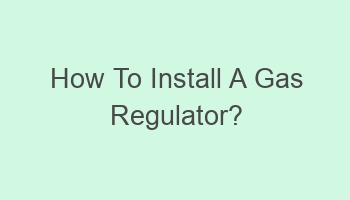How To Install A Gas Regulator?

Installing a gas regulator is a crucial step in ensuring the safety and efficiency of your gas system. This guide will walk you through the steps to install a gas regulator correctly. Before beginning the process, gather all necessary tools and equipment. Start by turning off the gas supply valve to the appliance. Next, disconnect the old regulator and attach the new one using a wrench. Make sure to check for any leaks by applying a solution of water and soap. Once everything is secure, turn the gas supply back on and test the appliance. Following these instructions for installing a gas regulator will help you complete the task safely and effectively.
Contents
| Turn off gas supply before beginning installation. |
| Use pipe wrench to remove old regulator. |
| Apply thread sealant to new regulator’s threads. |
| Secure new regulator in place with wrench. |
| Check for leaks using soapy water solution. |
- Adjust regulator pressure to recommended levels.
- Ensure proper venting for regulator operation.
- Test regulator functionality before use.
- Follow manufacturer’s instructions for installation.
- Seek professional help if unsure about installation process.
What Are The Necessary Tools For Installing A Gas Regulator?
To install a gas regulator, you will need a wrench, Teflon tape, pipe joint compound, and a pressure gauge. These tools are essential for ensuring a proper and secure installation.
- Wrench: Used to tighten the connections securely.
- Teflon Tape: Helps create a tight seal between threaded connections.
- Pipe Joint Compound: Provides additional sealing for threaded connections.
- Pressure Gauge: Used to monitor the gas pressure during installation.
Where Should I Install The Gas Regulator?
The gas regulator should be installed as close to the gas source as possible to ensure accurate pressure regulation. It should be positioned in a well-ventilated area away from any heat sources or potential hazards.
| Tip 1: | Install the gas regulator in a vertical position to prevent debris from entering the regulator. |
| Tip 2: | Ensure the regulator is easily accessible for maintenance and adjustment. |
How Do I Connect The Gas Regulator To The Gas Line?
To connect the gas regulator to the gas line, you will need to use a wrench to tighten the connections securely. Apply Teflon tape or pipe joint compound to the threaded connections to create a tight seal and prevent leaks.
- Step 1: Turn off the gas supply before starting the installation process.
- Step 2: Attach the regulator to the gas line using a wrench to tighten the connections.
- Step 3: Apply Teflon tape or pipe joint compound to the threaded connections.
When Should I Test The Gas Regulator After Installation?
After installing the gas regulator, it is essential to test it for leaks and proper pressure regulation. Testing should be done before connecting any appliances to ensure safe operation.
| Tip: | Use a soapy water solution to check for leaks – bubbles will form at the connection points if there is a leak. |
Why Is Proper Ventilation Important During Gas Regulator Installation?
Proper ventilation is crucial during gas regulator installation to prevent the accumulation of gas fumes, which can be hazardous. Adequate ventilation ensures the safe operation of the gas regulator and reduces the risk of gas leaks.
- Tip: Install the gas regulator in a well-ventilated area to maintain a safe environment.
Which Safety Precautions Should I Follow When Installing A Gas Regulator?
When installing a gas regulator, it is essential to follow safety precautions to prevent accidents or gas leaks. Make sure to turn off the gas supply before starting the installation and wear protective gear such as gloves and safety goggles.
| Tip 1: | Check for gas leaks using a gas leak detector before turning on the gas supply. |
| Tip 2: | Have a fire extinguisher nearby in case of emergencies. |
Can I Install A Gas Regulator Myself?
While it is possible to install a gas regulator yourself, it is recommended to hire a professional plumber or gas technician for complex installations. DIY installation may void warranties or cause safety hazards if not done correctly.
- Tip: If you are unsure about installing a gas regulator, seek professional help to ensure a safe and proper installation.
What Are The Common Mistakes To Avoid During Gas Regulator Installation?
Some common mistakes to avoid during gas regulator installation include overtightening connections, using the wrong tools, and neglecting to test for leaks. These mistakes can lead to gas leaks, pressure irregularities, and safety hazards.
| Mistake 1: | Overtightening connections can damage the threads and cause leaks. |
| Mistake 2: | Using the wrong tools may result in improper installation and leaks. |
How Often Should I Maintain The Gas Regulator After Installation?
Regular maintenance of the gas regulator is essential to ensure its proper functioning and safety. It is recommended to inspect the regulator for leaks and pressure irregularities at least once a year or as recommended by the manufacturer.
- Tip: Schedule annual maintenance checks with a qualified technician to keep your gas regulator in optimal condition.